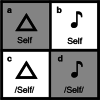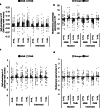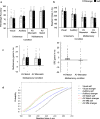Self-prioritization with unisensory and multisensory stimuli in a matching task
- PMID: 35538291
- PMCID: PMC9232425
- DOI: 10.3758/s13414-022-02498-z
Self-prioritization with unisensory and multisensory stimuli in a matching task
Abstract
A shape-label matching task is commonly used to examine the self-advantage in motor reaction-time responses (the Self-Prioritization Effect; SPE). In the present study, auditory labels were introduced, and, for the first time, responses to unisensory auditory, unisensory visual, and multisensory object-label stimuli were compared across block-type (i.e., trials blocked by sensory modality type, and intermixed trials of unisensory and multisensory stimuli). Auditory stimulus intensity was presented at either 50 dB (Group 1) or 70 dB (Group 2). The participants in Group 2 also completed a multisensory detection task, making simple speeded motor responses to the shape and sound stimuli and their multisensory combinations. In the matching task, the SPE was diminished in intermixed trials, and in responses to the unisensory auditory stimuli as compared with the multisensory (visual shape+auditory label) stimuli. In contrast, the SPE did not differ in responses to the unisensory visual and multisensory (auditory object+visual label) stimuli. The matching task was associated with multisensory 'costs' rather than gains, but response times to self- versus stranger-associated stimuli were differentially affected by the type of multisensory stimulus (auditory object+visual label or visual shape+auditory label). The SPE was thus modulated both by block-type and the combination of object and label stimulus modalities. There was no SPE in the detection task. Taken together, these findings suggest that the SPE with unisensory and multisensory stimuli is modulated by both stimulus- and task-related parameters within the matching task. The SPE does not transfer to a significant motor speed gain when the self-associations are not task-relevant.
Keywords: Auditory labels; Blocked vs. intermixed; Matching; Multisensory; Self-prioritization; Self-relevance; Simple detection.
© 2022. The Author(s).
Figures





Similar articles
-
Top-down task-specific determinants of multisensory motor reaction time enhancements and sensory switch costs.Exp Brain Res. 2021 Mar;239(3):1021-1034. doi: 10.1007/s00221-020-06014-3. Epub 2021 Jan 30. Exp Brain Res. 2021. PMID: 33515085 Free PMC article.
-
Probing Electrophysiological Indices of Perceptual Awareness across Unisensory and Multisensory Modalities.J Cogn Neurosci. 2018 Jun;30(6):814-828. doi: 10.1162/jocn_a_01247. Epub 2018 Feb 28. J Cogn Neurosci. 2018. PMID: 29488853 Free PMC article.
-
Unisensory processing and multisensory integration in schizophrenia: a high-density electrical mapping study.Neuropsychologia. 2011 Oct;49(12):3178-87. doi: 10.1016/j.neuropsychologia.2011.07.017. Epub 2011 Jul 22. Neuropsychologia. 2011. PMID: 21807011 Free PMC article.
-
The efficacy of single-trial multisensory memories.Multisens Res. 2013;26(5):483-502. doi: 10.1163/22134808-00002426. Multisens Res. 2013. PMID: 24649531 Review.
-
A multisensory perspective on object memory.Neuropsychologia. 2017 Oct;105:243-252. doi: 10.1016/j.neuropsychologia.2017.04.008. Epub 2017 Apr 8. Neuropsychologia. 2017. PMID: 28400327 Free PMC article. Review.
Cited by
-
How far can the self be extended? Automatic attention capture is triggered not only by the self-face.Front Psychol. 2023 Nov 3;14:1279653. doi: 10.3389/fpsyg.2023.1279653. eCollection 2023. Front Psychol. 2023. PMID: 38023055 Free PMC article.
References
-
- Alexopoulos T, Muller D, Ric F, Marendaz C. I, me, mine: Automatic attentional capture by self-related stimuli. European Journal of Social Psychology. 2012;42(6):770–779. doi: 10.1002/ejsp.1882. - DOI
MeSH terms
LinkOut - more resources
Full Text Sources
Miscellaneous

